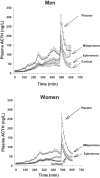Pulsatile Cortisol Feedback on ACTH Secretion Is Mediated by the Glucocorticoid Receptor and Modulated by Gender
- PMID: 27548106
- PMCID: PMC5095237
- DOI: 10.1210/jc.2016-2405
Pulsatile Cortisol Feedback on ACTH Secretion Is Mediated by the Glucocorticoid Receptor and Modulated by Gender
Abstract
Context: Factors that regulate physiological feedback by pulses of glucocorticoids on the hypothalamic-pituitary unit are sparsely defined in humans in relation to gluco- or mineralocorticoid receptor pathways, gender, age, and the sex steroid milieu.
Objective: The objective of the study was to test (the clinical hypothesis) that glucocorticoid (GR) and mineralocorticoid (MR) receptor-selective mechanisms differentially govern pulsatile cortisol-dependent negative feedback on ACTH output (by the hypothalamo-pituitary unit) in men and women studied under experimentally defined T and estradiol depletion and repletion, respectively.
Setting: The study was conducted at the Mayo Center for Translational Science Activities.
Subjects: Healthy middle-aged men (n = 16) and women (n = 25) participated in the study.
Interventions: This was a randomized, prospective, double-blind, placebo- and saline-controlled study of pulsatile cortisol infusions in low cortisol-clamped volunteers with and without eplerenone (MR blocker) and mifepristone (GR blocker) administration under a low and normal T and estradiol clamp. During frequent sampling, a bolus of CRH-arginine vasopressin was infused to assess corticotrope responsiveness. Analytical Methods and Outcomes: Deconvolution and approximate entropy of ACTH profiles were measured.
Results: Infusion of cortisol (but not saline) pulses diminished ACTH secretion. The GR antagonist, mifepristone, interfered with negative feedback on both ACTH burst mass and secretion regularity. Eplerenone, an MR antagonist, exerted no detectable effect on the same parameters. Despite feedback imposition, CRH-arginine vasopressin-stimulated ACTH secretion was also increased by mifepristone and not by eplerenone. Withdrawal vs addback of sex steroids had no effect on ACTH secretion parameters. Nonetheless, ACTH secretion was greater (P = .006) and more regular (P = .004) in men than women.
Conclusion: Pulsatile cortisol feedback on ACTH secretion in this paradigm is mediated by the glucocorticoid receptor, in part acting at the level of the pituitary, and influenced by sex.
Figures





Similar articles
-
Estradiol, but not testosterone, heightens cortisol-mediated negative feedback on pulsatile ACTH secretion and ACTH approximate entropy in unstressed older men and women.Am J Physiol Regul Integr Comp Physiol. 2014 May;306(9):R627-35. doi: 10.1152/ajpregu.00551.2013. Epub 2014 Feb 26. Am J Physiol Regul Integr Comp Physiol. 2014. PMID: 24573184 Free PMC article. Clinical Trial.
-
Mineralocorticoid receptor blockade by canrenoate increases both spontaneous and stimulated adrenal function in humans.J Clin Endocrinol Metab. 2001 Jul;86(7):3176-81. doi: 10.1210/jcem.86.7.7663. J Clin Endocrinol Metab. 2001. PMID: 11443185 Clinical Trial.
-
Combined receptor antagonist stimulation of the hypothalamic-pituitary-adrenal axis test identifies impaired negative feedback sensitivity to cortisol in obese men.J Clin Endocrinol Metab. 2009 Apr;94(4):1347-52. doi: 10.1210/jc.2008-2054. Epub 2009 Jan 13. J Clin Endocrinol Metab. 2009. PMID: 19141586 Clinical Trial.
-
Dynamics of the regulation of the hypothalamo-pituitary-adrenal (HPA) axis determined using a nonsurgical method for collecting pituitary venous blood from horses.Front Neuroendocrinol. 1996 Jan;17(1):1-50. doi: 10.1006/frne.1996.0001. Front Neuroendocrinol. 1996. PMID: 8788568 Review.
-
The glucocorticoid receptor and RU 486 in man.Ann N Y Acad Sci. 1995 Jun 12;761:296-310. doi: 10.1111/j.1749-6632.1995.tb31385.x. Ann N Y Acad Sci. 1995. PMID: 7625728 Review.
Cited by
-
Adrenal insufficiency.Nat Rev Dis Primers. 2021 Mar 11;7(1):19. doi: 10.1038/s41572-021-00252-7. Nat Rev Dis Primers. 2021. PMID: 33707469 Review.
-
Regulation of Pulsatile and Entropic ACTH Secretion Under Fixed Exogenous Secretagogue Clamps.J Clin Endocrinol Metab. 2017 Jul 1;102(7):2611-2619. doi: 10.1210/jc.2017-00115. J Clin Endocrinol Metab. 2017. PMID: 28368521 Free PMC article. Clinical Trial.
-
Impact of total intravenous anesthesia and total inhalation anesthesia as the anesthesia maintenance approaches on blood glucose level and postoperative complications in patients with type 2 diabetes mellitus: a double-blind, randomized controlled trial.BMC Anesthesiol. 2023 Aug 9;23(1):267. doi: 10.1186/s12871-023-02199-6. BMC Anesthesiol. 2023. PMID: 37559041 Free PMC article. Clinical Trial.
-
Adrenocorticotropic Hormone (ACTH) and Cortisol Monitoring as Stress Markers During Laparoscopic Cholecystectomy: Standard and Low Intraabdominal Pressure and Open Cholecystectomy.Med Arch. 2019 Aug;73(4):257-261. doi: 10.5455/medarh.2019.73.257-261. Med Arch. 2019. PMID: 31762561 Free PMC article.
-
Efficacy of Synthetic Peptide Corresponding to the ACTH-Like Sequence of Human Immunoglobulin G1 in Experimental Autoimmune Encephalomyelitis.Front Pharmacol. 2018 Feb 23;9:113. doi: 10.3389/fphar.2018.00113. eCollection 2018. Front Pharmacol. 2018. PMID: 29527165 Free PMC article.
References
-
- de Goeij DC, Kvetnansky R, Whitnall MH, Jezova D, Berkenbosch F, Tilders FJ. Repeated stress-induced activation of corticotropin-releasing factor neurons enhances vasopressin stores and colocalization with corticotropin-releasing factor in the median eminence of rats. Neuroendocrinology. 1991;53(2):150–159. - PubMed
-
- Honkaniemi J, Pelto-Huikko M, Rechardt L, et al. Colocalization of peptide and glucocorticoid receptor immunoreactivities in rat central amygdaloid nucleus. Neuroendocrinology. 1992;55(4):451–459. - PubMed
-
- Watts AG, Sanchez-Watts G. Physiological regulation of peptide messenger RNA colocalization in rat hypothalamic paraventricular medial parvicellular neurons. J Comp Neurol. 1995;352(4):501–514. - PubMed
Publication types
MeSH terms
Substances
Grants and funding
LinkOut - more resources
Full Text Sources
Other Literature Sources

